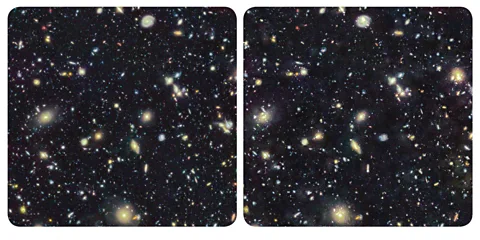 J-P MetsaivanioMetsaivanio meticulously removed stars to show a field of far-off galaxies, originally taken by the Hubble Space Telescope (Credit: J-P Metsaivanio)
J-P MetsaivanioMetsaivanio meticulously removed stars to show a field of far-off galaxies, originally taken by the Hubble Space Telescope (Credit: J-P Metsaivanio)
“I’m a star destroyer – and a lot of planets, probably – when I remove all the stars from our Milky Way,” says Metsaivanio. “When you look at the picture of the Andromeda, what you will see here in 3D is with the stars from the Milky Way,” he says, motioning towards the screen set up for the night’s projection. “When I remove them, you see the Andromeda, as you [would] see it outside of the Milky Way. And then this make you realise that those stars that were in front of the picture. I removed them. There is nothing between us and Andromeda and emptiness for 2.5 million light years. That’s mind-blowing.”
What’s also mind-blowing is the amount of work that has to go into his creations; during one unveiling later that night of an image of the Milky Way, he admits that the finished image took him 12 years of work to complete, including more than 1,200 different exposures.
The book was written by Ward-Thompson and edited by Sir Brian, explaining the evolution of the galaxies we can now see in deep space. The galaxies shown are as colourful and varied as microscopic life on a lab slide; NGC 253 gleams in blue and gold like an antique pendant; NGC 3925 has rings like that of a disturbed pond, the waves created perhaps by a smaller galaxy colliding with it and causing a “splash”. One image shows two galaxies, NGC 4567 and 4568, in the process of colliding, crashing into each other in what Ward-Thompson has called a “train wreck of the cosmos”.
More like this:
• The space race like you’ve never seen it before


